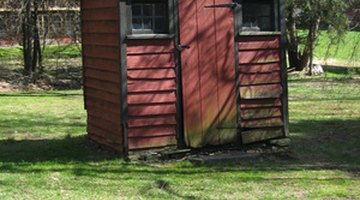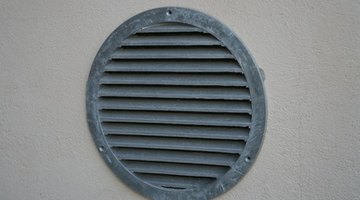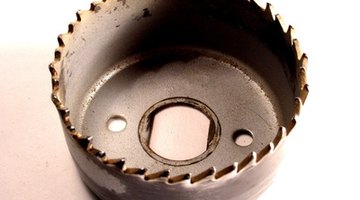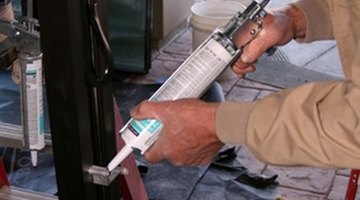How to Vent an Outhouse
Put an end to smelly outhouses with a well designed vent system. Harness the energy of the sun to pull odors up and out through a vent stack, through the process of convection.

This vent system design relies on an airtight outhouse with only one way for air to enter the interior, usually through a wall vent toward the top of outhouse where wind is most likely to pass through.
Things You Will Need
- 4-inch diameter vent pipe long enough to start at the floor of your outhouse and extend 3 feet above the roof line
- black paint
- single wall vent
- door latch or lock
- hole saw
- caulk
Tip
Electric and battery-operated toilet vent fans are available for 4-inch vent pipes if you prefer to rely on manufactured energy instead of the sun to power your vent. If your outhouse tends to get hot add insulation to the roof to protect it from the heat of the sun. If the interior gets as hot as the black area of the vent pipe, air wont flow.
Warning
Do not use a toilet seat that seals to the hole. It is important to let air flow freely through the opening. A seat is alright if it is raised off the surface.
Keep the outhouse door closed when it is not in use. Leaving the door open will only allow the odor from the waste compartment to vent itself into the outhouse interior. Close the door for your vent system to work effectively.
The top of your vent pipe can not be covered with material such as screen or a vent cover. Doing so will prohibit natural airflow not vent sufficiently.
A Simple Air Flow Vent System
-
Create an airtight outhouse by sealing windows and installing a latch that allows the door to close tightly.
-
Install a free flowing air vent—at least 100 square inches in size—in the top portion of the outhouse wall, allowing outside air to come in.
-
Cut a circular hole in the flat surface behind your toilet seat. Make the hole slightly smaller than the diameter of your 4-inch vent pipe. Cut a hole through the ceiling and roof that is slightly larger than the diameter of the vent pipe. The pipe will run from the lower hole through roof extend 3 feet beyond the roof.
-
Paint the top 3 feet of your vent pipe black. Black attracts the sun which warms the top of the pipe. This creates air flow by convection; warm air will force itself up through the vent pipe followed by odorous, gaseous air from the pit, through the toilet seat. On a hot day you might feel a breeze inside the the outhouse when there is no breeze outside.
-
Slide the vent pipe in place by putting it through the roof first and setting it on the smaller hole near the toilet seat. Finally caulk around the pipe and any other cracks or holes in your outhouse.





The Drip Cap
- Put an end to smelly outhouses with a well designed vent system.
- This vent system design relies on an airtight outhouse with only one way for air to enter the interior, usually through a wall vent toward the top of outhouse where wind is most likely to pass through.
- Cut a hole through the ceiling and roof that is slightly larger than the diameter of the vent pipe.
- Paint the top 3 feet of your vent pipe black.
References
Resources
Writer Bio
Jennifer Dermody started writing in 1992. She has been published in "Running Wild Magazine," "The Green Book" environmental bid journal and local publications in the areas that she has lived all over the world. She is currently a licensed Florida real estate agent. Dermody earned her Bachelor of Arts degree in communications from Regis College in 1993.
Photo Credits
- outhouse image by Susan Rae Tannenbaum from Fotolia.com
- outhouse image by Susan Rae Tannenbaum from Fotolia.com
- outhouse image by mark-images from Fotolia.com
- air vent image by Vladimir Titov from Fotolia.com
- Bohreraufsatz image by Ewe Degiampietro from Fotolia.com
- paint brush image by jimcox40 from Fotolia.com
- glazier image by Greg Pickens from Fotolia.com
More Articles



